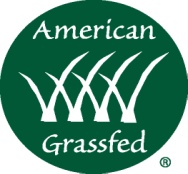

P.O. Box 46-1090, Denver, CO 80246 877-774-7277 (phone and fax)
©2011, American Grassfed Association. Please use with attribution.
The Top Ten Health Reasons to Eat Grassfed Beef
According to a 2009 study1 conducted by the USDA and Clemson University, grassfed beef is better for human health than grainfed beef in ten ways:
- Lower in total fat
- Higher in beta-carotene
- Higher in vitamin E (alpha-tocopherol)
- Higher in the B-vitamins thiamin and riboflavin
- Higher in the minerals calcium, magnesium, and potassium
- Higher in total omega-3s
- Better ratio of omega-6 to omega-3 fatty acids (1.65 vs 4.84)
- Higher in conjugated linoleic acid
- Higher in vaccenic acid
- Lower in the saturated fats linked with heart disease
What does that mean for consumers?
1. Lower in total fat
Cows were designed to eat grass, which means that they process it and maintain a healthy digestive system. Feedlot cattle are finished with a grain diet, mainly corn and soy, which makes for a quick weight gain and a higher percentage of fat in the tissue.
Grainfed cattle also receive hormones in the diet, again to make them grow fast and gain weight quickly. This also results in a higher fat content in the muscle. Pasture-raised cattle are not given artificial hormones and so are naturally more lean than their feedlot counterparts. According to the Duckett study, the overall total fat content of pasture-raised cattle is usually about 25% lower than grainfed cattle.
Since grassfed meat is lean, it is also lower in calories than grainfed.
2. Higher in beta-carotene
According to a California State University study2, meat from pasture-fed steers contains a seven-fold higher concentration of beta-carotene than grain-fed animals. This is probably a result of the high beta-carotene content of fresh grasses as compared to cereal grains. Beta-carotenes are precursors of retinol (Vitamin A), a critical fat-soluble vitamin that is important for normal vision, bone growth, reproduction, and cell division. The overall integrity of skin and mucous membranes is maintained by vitamin A, creating a barrier to bacterial and viral infection. In addition, vitamin A is involved in the regulation of immune function by supporting the production and function of white blood cells.
3. Higher in vitamin E (alpha-tocopherol)
The meat from the grassfed cattle is four times higher in vitamin E than meat from feedlot cattle and almost twice as high as meat from feedlot cattle that have been given vitamin E supplements.3
In humans, vitamin E is linked with a lower risk of heart disease and cancer. This potent antioxidant may also have anti-aging properties. Most Americans are deficient in vitamin E.
4. Higher in the B-vitamins thiamin and riboflavin
Thiamine, also known as Vitamin B1, helps to maintain the body’s energy supplies, coordinates the activity of nerves and muscles and supports proper heart function. Riboflavin, Vitamin B2, helps protect cells from oxygen damage, supports cellular energy production and helps to maintain the body’s supply of other B vitamin
5. Higher in the minerals calcium, magnesium and potassium
Calcium helps maintain healthy, strong bones; supports the proper functioning of nerves and muscles and helps blood to clot. Magnesium helps to relax nerves and muscles, builds and strengthens bones and keeps the blood circulating smoothly. Potassium helps to maintain the proper electrolyte and acid-base balance in the body and helps lower the risk for high blood pressure.
6. Higher in total Omega 3s
Omega 3 and Omega 6 fatty acids are polyunsaturated fats that play an important part in growth and metabolism. They can’t be synthesized by the human body, so they have to come from our diet. Omega 3s reduce inflammation, lower the amount of serum cholesterol and triglycerides, prevent excess clotting and reduce the risk of cancer.
7. Better ratio of Omega 6 to Omega 3
While both Omega 3 and Omega 6 fatty acids are important individually, they also work in tandem and the ratio is critical. According to a 2008 study,4 a typical Western diet can be excessively heavy on the Omega 6s – up to a 30:1 ratio – when the ideal is closer to 1:1. While the body requires some Omega 6, an excess can foster cardiovascular disease, cancer, and autoimmune disorders, which are suppressed by Omega 3s. The proper ratio can reduce the risk of those and other chronic illnesses.
8. Higher in conjugated linoleic acid
CLA is another potent weapon in the arsenal against chronic disease. CLA can reduce cancer, high blood pressure, cardiovascular disease, osteoporosis and insulin resistance.
9. Higher in vaccenic acid
Vaccenic acid is a transfat that occurs naturally in ruminant animals, but unlike its synthetically-produced cousins, is important for good health. A recent study5 published in The Journal of Nutrition showed that vaccenic acid protects against atherosclerosis, a contributing factor in cardiovascular disease.
10. Lower in the saturated fats linked with heart disease
Saturated fats (cholesterol, triglycerides and low-density lipoproteins – LDL or “bad” cholesterol) all play a significant role in heart disease and stroke.
The choice is clear – grassfed beef is the healthy way to eat!
1 S. K. Duckett, et al. “Effects of winter stocker growth rate and finishing system on: III. Tissue proximate, fatty acid, vitamin, and cholesterol content.” Journal of Animal Science. June 5, 2009, doi: 10.2527/jas.2009-1850.
2 C.A. Daley, et al. “A review of fatty acid profiles and antioxidant content in grass-fed and grain-fed beef.” Nutrition Journal 2010, 9:10
3 Smith, G.C. “Dietary supplementation of vitamin E to cattle to improve shelf life and case life of beef for domestic and international markets.” Colorado State University, Fort Collins, Colorado 80523-1171
4 Simopoulos AP. “The importance of the omega-6/omega-3 fatty acid ratio in cardiovascular disease and other chronic diseases.” Experimental Biology and Medicine. 2008 Jun;233(6):674-88.
5 Adam L. Lock, et al. “Butter Naturally Enriched in Conjugated Linoleic Acid and Vaccenic Acid Alters Tissue Fatty Acids and Improves the Plasma Lipoprotein Profile in Cholesterol-Fed Hamsters.” J. Nutr. August 2005 135: 1934-1939